ADS experience vs the selection, procurement and use of automotive parts in space programs
- Posted by Simon Albert
- On November 18, 2019
- 0
Agenda
- Why to use automotive parts in space?
-
- Space Market Evolution
- Meeting the requirements
-
- AEC-Q Principles
-
- Production Part Approval Process (PPAP)
- Comparing Hi-Rel and Automotive Standards
-
- Selection of Automotive Components for Space
- Procurement of Automotive Components for Space
- Use of Automotive Components for Space
- Main Takeaways
Why to use automotive parts in space? – Space Market Evolution
- the use of automotive parts in space programs seems to be beneficial due to the change of needs in the space market
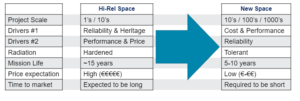
-> Changing needs call for new approaches / methodologies / concepts
Why to use automotive parts in space? – Meeting the requirements
- to what degree do different kind of parts meet the requirements for space programs
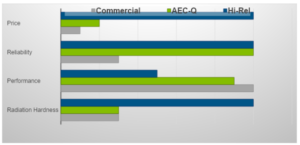
- automotive components are the best compromise between price & reliability (excluding radiation) for space
-> AEC-Q components provide a good compromise between price & reliability for space programs (excluding radiation)
AEC-Q Principles
- AEC-Q documents specify how to qualify components and to requalify them in case of material or process changes.
- There is no AEC Qualifying Body, auditing the manufacturers or certifying it has met the qualification requirements:
- Manufacturers self-certify their compliance to AEC-Q requirements
- Each user is responsible to review the qualification data to verify the compliance to AEC-Q requirements
- Quality is based on:
- Heavy qualification procedure (several hundreds of parts)
- Determination of Early Life Failure Rate (ELFR) – for microcircuits
- Strict control of material and process changes
- SPC (Statistical Process Control) based on volume
- Different grades of components are defined according to their temperature range with associated qualification tests.
- Grade 0 : -40C to +150C (microcircuits) or -50C to +150C (passive)
- Grade 1 : -40C to +125C (microcircuits & passive)
- Grade 2 : -40C to +105C (microcircuits & passive)
- Grade 3 : -40C to +85C (microcircuits & passive)
- Grade 4 : 0C to +70C (passive – non-automotive)
- As a result:
- No screening process is imposed.
- No periodic lot qualification is required.
Production Part Approval Process (PPAP)
- PPAP defines the approval process for new or revised parts, or parts produced from new or significantly revised production methods.
- There are 5 levels of PPAP submission. Generally Automotive uses the level 3 : Part Submission Warrant (PSW) with product sample and complete supporting data.
- The PPAP process consists of 18 elements that may be required for approval of production level parts. Not all of the elements are required for every submission.
- Design Documentation
- Engineering Change Documentation
- Customer Engineering Approval
- Design Failure Mode and Effect Analysis (DFMEA)
- Process Flow Diagram
- Process Failure Mode and Effect Analysis (PFMEA)
- Control Plan
- Measurement System Analysis Studies
- Dimensional Results
- Records of Material / Performance Tests
- Initial Process Studies
- Qualified Laboratory Documentation
- Appearance Approval Report
- Sample Production Parts
- Master Sample
- Checking Aids
- Customer Specific Requirements
- Part Submission Warrant (PSW)
- The resulting PPAP submission provides the evidence that the supplier has met or exceeded the customer’s requirements and the process is capable of consistently reproducing quality parts.
- Contrary, in space, CoC (Certificate of Compliance) certifies that a series of tests has been done. It does not warrant a failure rate of components.
Comparing Hi-Rel and Automotive Standards
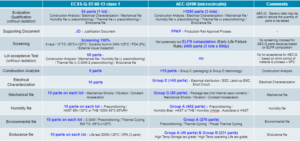
Comparing Hi-Rel and Automotive Parts – A Summary
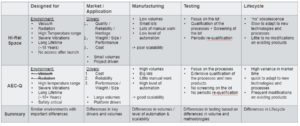
-> make use of the advantages & manage the differences!
Selection of Automotive Components for Space
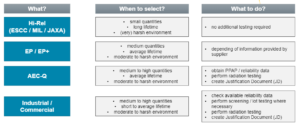
-> it’ not about either … or …, it’s about both … and …!
Selection of Automotive Components for Space
- two experiences when selecting automotive parts:

- overall it is important to put high emphasis on the selection process
-
- strive for standardization (PPL / EEE Roadmap)
- well connected multifunctional teams required
-
- connecting experts with regards to radiation, EEE parts, design, manufacturing, testing, procurement & customer support
-
- have clear requirements / establish reliable & efficient processes for additional testing
- make sure data & information is stored and well accessible
-
Procurement of Automotive Components for Space
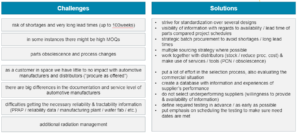
Use of Automotive Components by ADS in New Space programs
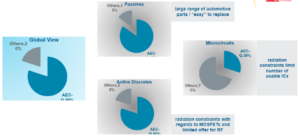
Main Takeaways
- AEC-Q parts are a good alternative for usage in space programs
-
- low price / high reliability / very low dispersion
- there are inherent differences between AEC and Hi-Rel methodologies, which have to be managed
- there are a variety of component levels available! It’s the challenge of the user to identify what the best fit for the parts need is (Hi-Rel / EP / AEC-Q / Commercial)
-
- Put high emphasis on the evaluation & the selection process of parts
-
- strive for standardization (PPL / EEE Roadmap)
- well connected multifunctional teams required
-
- connecting experts with regards to radiation, EEE parts, design, manufacturing, testing, procurement & customer support
-
- have clear requirements / establish reliable & efficient processes for additional testing
- make sure data & information is stored and well accessible
-
- Experiences made with “automotive” parts
-
- “automotive” / “automotive qualified” / “automotive applications” is often not “AEC-Q xxx”
-
- Some manufacturers states that AEC-Q is taken only as a guideline
- Some manufacturers declare to be AEC-Q qualified but no data is available on their websites or upon request
- Some testing conditions of procured parts haven’t been compliant to AEC-Q requirements when checked
- due to the limited volume in space we experienced difficulties in receiving the necessary information (e.g. PPAP)
-
- “automotive” / “automotive qualified” / “automotive applications” is often not “AEC-Q xxx”
-
-> responsibility of the buyer to check documentation and adherence to AEC standards
-> need for Justification Document for AEC-Q parts
The Authors
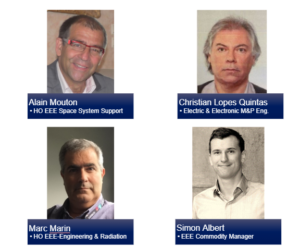


0 comments on ADS experience vs the selection, procurement and use of automotive parts in space programs